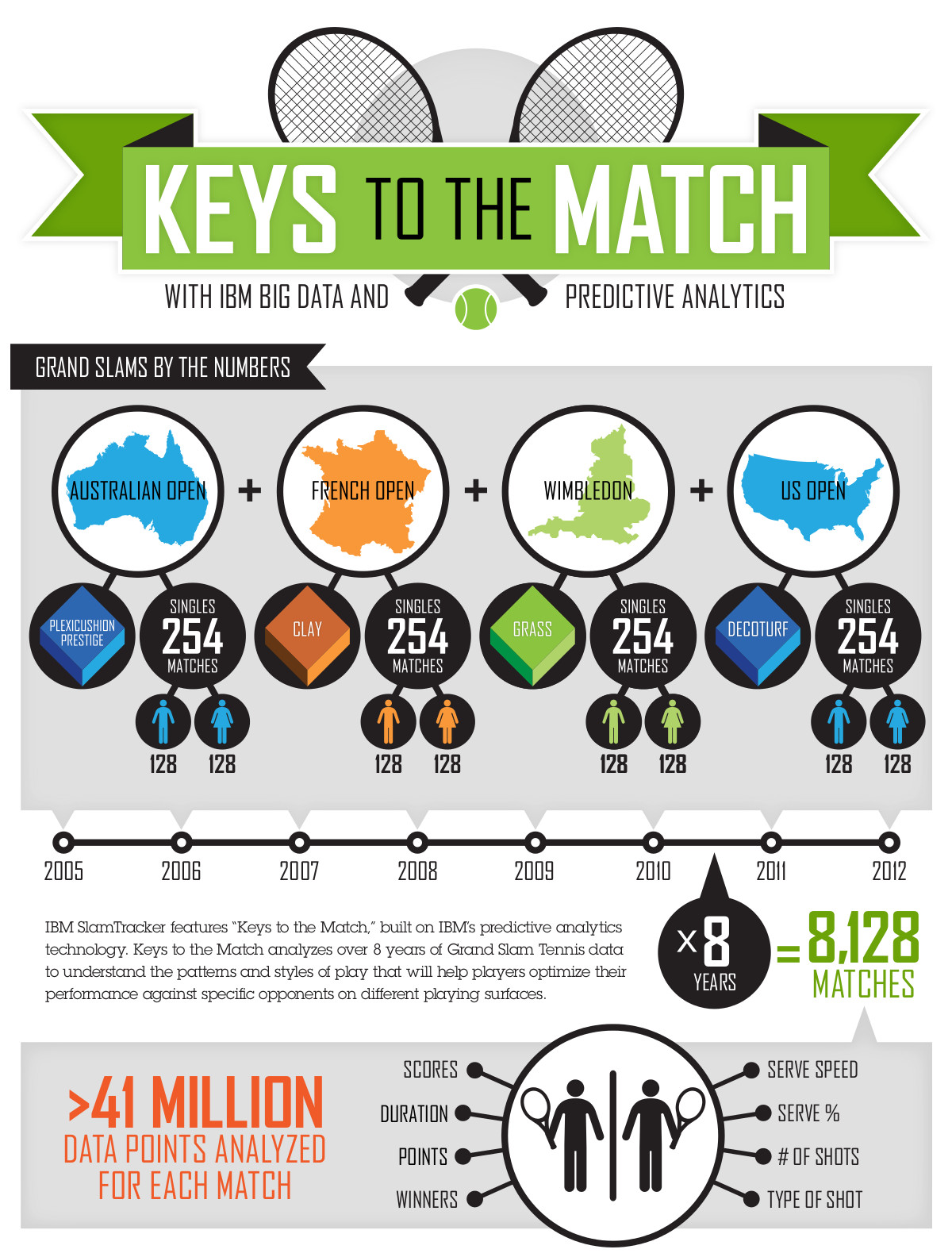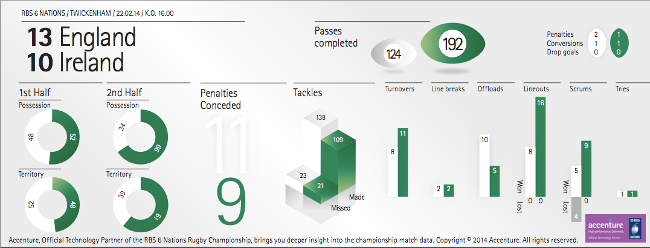Ireland's Paul O'Connell wins a line-out during the RBS Six Nations match against England at Twickenham Stadium, London, 2010 (photo via Mitch Gunn/Shutterstock)
Big data has seeped into all aspects of life and the sporting world is no exception. Data analytics has been applied to sport as varied as cricket, football, American football, basketball, rugby, Gaelic games, motor racing, tennis and sailing.
Analytics isn’t solely put to use to improve performance, either. For IBM’s work with the Rugby Football Union (RFU), the original objective was to engage with fans and, for this, they created TryTracker.
Data for die-hards and newcomers alike
TryTracker is intended to make rugby accessible to new fans by providing a better understanding of the game, says Alex Phillips, senior managing consultant on business analytics and optimisation at IBM Global Business Services UK and Ireland.
This was also the case in cricket, a sport that demonstrates early adoption of new technology, according to Will Gatehouse, big data lead for Accenture in Europe, Africa and Latin America (EALA).
Gatehouse cites the use of Hawk-Eye and extensive, detailed television coverage to encourage more cricket fans. “All that feedback is giving the fans a deeper insight into how that game is being played,” he said. “Not only are the die-hard people able to the get the insight, it really helps to explain to the armchair-type fans, too.”
The media has also copped on to this necessary fan-service, and both Phillips and Gatehouse have noted a surge in interest coming from various outlets wanting to attract fans to their coverage. “A couple of the media outlets are interested in seeing how we take the numbers and make them more intuitive for the fans, to be able to tell a story. And linked to that is the technology underneath it,” said Gatehouse.
Network support
Between the coaches, the fans and the media, there’s no dearth of people wanting to get their mitts on sports data. There’s also a wealth of sources from which it can be gathered.
We have high-definition cameras positioned throughout stadiums and arenas to document every movement. We have GPS satellites honing in on sensors embedded in athletes’ clothing. We have wearable technology monitoring their heart rate and other health indicators. There’s certainly no shortage of data points being created at any single sporting event.
But all of this data streaming in and out from myriad sources has to be supported somehow.

A Seattle Seahawks fan enjoys Super Bowl XLVIII at the MetLife Stadium, New Jersey (photo via Jai Agnish/Shutterstock)
“We live in an application-led world,” said Steve Johnson, head of networking company Extreme Networks’ UK and Ireland arm. Smart devices are becoming more and more commonplace and Johnson notes the huge amount of data now flowing through networks.
During Super Bowl XLVIII last month, 3.2Tb of data flowed through the MetLife Stadium’s network, as measured by Extreme Networks’ Purview system. Johnson notes that the majority of this traffic came from social networking. “The dominant social media application was Facebook,” he revealed.
In fact, 60pc of the Wi-Fi-connected fans at this year’s Super Bowl were using Facebook. Johnson assumes a large chunk of this activity came from fans uploading photos with a status update – a bandwidth-intensive activity.
“If that’s what the fans really want to do – and, for the first time, the NFL are able to see proof and evidence that that’s exactly what the fans want to be doing – then it’s up to the NFL to build the infrastructure that will support that,” he said.
Business-like strategies
Certainly, the level of data being collated on a minute-by-minute basis at today’s events is something that couldn’t be achieved five years ago. But it’s not just about the sheer amount of data, it’s what you do with it that counts.
“It’s not always the volume of the data that is the biggest factor, it can be the speed at which the data’s coming in, in which you have to do some complex calculations on it, that can be the most difficult aspect,” said Phillips.
For Phillips, IBM’s role is to cut down and pare back the data to find the useful information that will generate important insights. When this vital information is singled out, the true value of sports data is unearthed.

Infographic from IBM showing how its Wimbledon ‘Keys to the Match’ were calculated
“In some sports, yes, they’re using a lot [of analytics], but in other sports they’re capturing a lot of information and the challenge now and for the next couple of years is: how do you take that information and drive insight out of it that can actually be used?” said Gatehouse.
Overall, the sports data analytics process is similar to what Accenture applies across other industries. Just as businesses look for warning signs to inform forward-looking decisions, fitness data can indicate if a player might be susceptible to injury and would be better off sitting out a game or two – early intervention in order to get the most value out of a ‘product’ in the long-term, as it were.
By this measure, you can really see how sport is becoming more and more business-like. “The distinction between what is a sport and what is a business is very grey now,” said Gatehouse. “There are very strong correlations in my mind between how you’d run your business and how you’d run your team.”
Is data analytics a pre-requisite of success?
As sports data becomes more prolific and the ability to interpret this information is honed to a fine art, the ability to forecast outcomes will become stronger.
IBM’s TryTracker includes a ‘Keys to the Game’ feature, which looks at historical data and finds out what needs to be done in the current or upcoming game to have a better chance of winning. The value of these insights cannot be underestimated. “Typically, the team that makes more of their keys than the other team will go on to win the match,” said Phillips.
In games with near-equal competition, the team with the best insights could have the advantage. “When you’re getting to the point where games are won in such small margins, then [data analytics] is becoming crucial,” said Gatehouse.

Infographic from Accenture summarising Ireland’s performance against England at Twickenham in the RBS Six Nations 2014
What’s more, predictive analytics is only going to improve as the technology becomes more precise. One sport where this is already apparent is Formula One racing. In this case, mechanical elements – the race car and its parts – play a major role, which makes the data more reliable and outcomes more predictable.
While Gatehouse believes that even human players are becoming machines themselves, he concedes that there’s no amount of technology that can predict the impact of the psyche.
“Sometimes, analytics provides a very good insight. However, there are elements to the game and outside of the game that you might not be capturing, so it’s a very fine balance,” he said.
All told, statistics aren’t infallible. “[Statistics are] a very good indicator and there are very strong correlations at times, but it is not an exact science. If it was, then old Paddy would be out of business in the bookmaker’s,” said Gatehouse.
But if he who wields the data does indeed hold the keys to the game, and this level of technology comes at a high price, is the future of sports success reliant on investment in data infrastructure and analytics?
According to Gatehouse, just as businesses investing in analytics can become leaders in their field, so too can sports teams. But whether teams or institutions throw open their coffers to fund big data analysis is irrelevant unless they have the right interpreter.
“If you blindly go by analytics, then you will not be leading,” said Gatehouse. “It gives you the insight but I cannot see that you’ll have a computer coaching the Irish rugby team in the very near future, because you need the person in there.”
Main image by Mitch Gunn via Shutterstock